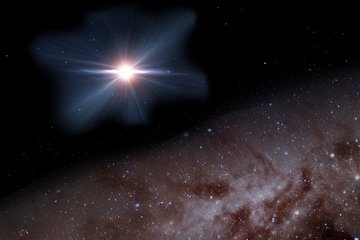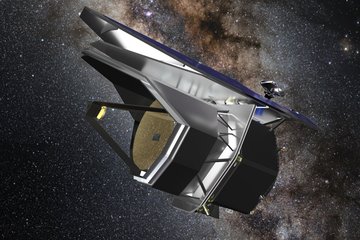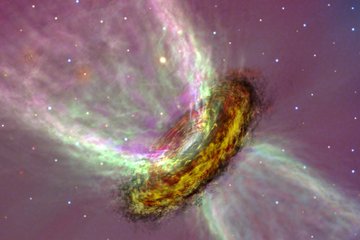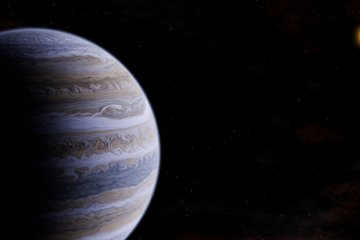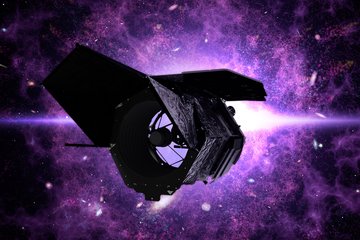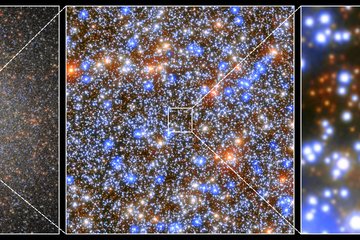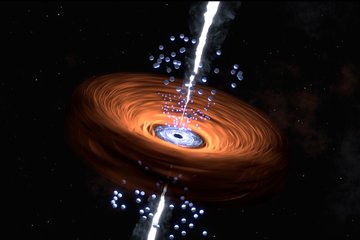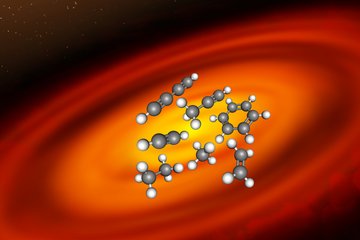Massive stellar embryos undergo episodic growth
A spiral structure in the disk around a young massive star suggests that gas is supplied in separate packets
The supply of massive stellar embryos with food from their surrounding disk of gas and dust has long been a mystery. An international research team, in which the Max Planck Institute for Astronomy is participating, has now discovered a spiral structure in such a disk, in the centre of which a growing star of about 12 solar masses has experienced a dramatic increase in brightness. This spiral confirms the hypothesis that such disks become temporarily unstable and therefore partially disintegrate into compact packets. These feed the young star in bites, resulting in episodes of sharply increasing luminosity. The results are published today in the journal Nature Astronomy.

High-mass stars, i.e. stars whose mass is at least eight times that of the Sun, differ in many ways from the low-mass stars, including the Sun. For a long time, astronomers were unable to explain convincingly how the material that fuels the protostars – the still young, unfinished stars – can overcome the enormous radiation pressure. A current study led by Xi Chen (Guangzhou University and Shanghai Astronomical Observatory, China) and Andrej Sobolev (Ural Federal University, Russia), in which the Max Planck Institute for Astronomy (MPIA) in Heidelberg is also involved, has now taken an important step towards clarifying this mystery.
As part of the globally cooperating Maser Monitoring Organization (M2O), the researchers discovered a spiral structure around the massive protostar G358-MM1, which is located 22,000 light years away. Astronomers predict this phenomenon theoretically for massive disks, which they suspect to form preferentially during the formation of massive stars. New material from a more distant envelope of gas and dust is constantly falling onto the disk, causing it to keep growing. It currently has a diameter of 1340 au (1 au = 1 astronomical unit = 149.6 million km).
Packets of matter from massive disks feed massive protostars

The gravitational pull of the central star affects such massive disks only partially. Instead, the gravitation of the disk itself has a significant effect on its stability, causing matter to move along paths that lead to the formation of a spiral. A further consequence of the instability is that the disk partially breaks up into dense, compact packages of gas and dust. These survive the fall on the luminous massive protostars despite the immense radiation pressure and thus lead to a growth in batches. This process, which astronomers call accretion, temporarily causes the luminosity of the protostar to rise sharply.
Because of the dense disk, however, the increase in brightness is difficult to observe. In the case of G358-MM1, this was found in part by measuring the far-infrared radiation released when the disk heats up. The detection of maser radiation is a technically simpler method. Masers are the counterpart to lasers, which, however, emit microwave radiation – or radio radiation – instead of visible light. They occur in massive star forming regions as natural, very bright and compact radiation sources. In a previous study, astronomers had identified the temporary flare of maser emission in G358-MM1 as an indication of a heat wave passing through the disk.
In the current study, the spiral structure was revealed by maser signals as well, again caused by a temporary sharp increase in radiative power caused by a new accretion burst. From the positions and velocity information of the detected masers, the scientists not only modelled the shape of the underlying configuration, but also concluded that matter flows along the spiral arms from the outer regions of the disk to the inside. From there, it gradually feeds the protostar, whose mass they determined at about 12 solar masses.
Relationship between episodic accretion and an unstable disk
“G358-MM1 is thus the first example of a massive protostar whose sudden increase in brightness clearly coincides with the formation of a spiral, a structure that suggests an unstable, massive disk,” explains Xi Chen. In conjunction with theoretical models, it is thus possible for the first time to establish a direct correlation between the variation in luminosity and the accretion of individual packets of matter from an unstable, massive disk. “This result suggests that disk-mediated accretion could therefore be regarded as a common mechanism for star formation of low-mass to high-mass stars,” notes Xi Chen.
Another surprise was the nature of the masers. So far, the disks with accretion activity mainly contained maser radiation of the methanol molecule, which is excited by the increased infrared radiation. However, the masers in the spiral were something completely new. On the one hand, this radiation was based on a special form of methanol, in which an ordinary carbon atom is replaced by a heavier carbon isotope, which has one neutron more than usual. On the other hand, the scientists found maser activity of heavy water. This carries a deuterium atom instead of a hydrogen atom. “Astronomers still want to find out the exact causes for the excitation of these particular molecules,” explains Hendrik Linz from MPIA, who was involved in the study. “Nonetheless, this shows that the conditions in these spiral arms, and thus in the massive disks, must be extraordinary.”
Background information
The study titled “New maser species tracing spiral-arm accretion flows in a high-mass young stellar object” was published in the journal Nature Astronomy (DOI: 10.1038/s41550-020-1144-x). Besides the main author, 18 scientists from 18 research institutes in 11 countries and 5 continents are involved in the publication.
The scientists used data from the Shanghai 65-metre Tianma Radio Telescope (TMRT; China) and the Karl G. Jansky Very Large Array (VLA; USA).
MN



